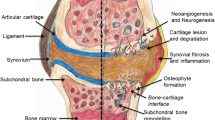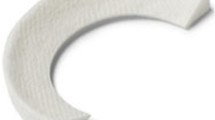Abstract
Purpose
Articular resurfacing by treatment of chondral defects may include chondral abrasion, autologous chondrocyte Implantation (ACI), matrix-induced chondrocyte transplantation (MACT) or osteochondral autologous transplantation (OATS). This technical note describes the method of autologous matrix-induced chondrogenesis (AMIC), a one-step procedure combining subchondral microfracture with the fixation of a collagen I/III membrane with fibrin glue or sutures.
Methods
This is a technical note on the AMIC procedure and its further development.
Results and conclusion
This method is applied primarily in chondral or osteochondral lesions of the knee. Indications and contraindications are provided; the technique is described. The further development of AMIC is described with an increased focus on the subchondral zone and the complex of cartilage and bone, the osteochondral unit, which receives increased attention in cartilage research.
Level of evidence
IV.



Similar content being viewed by others
References
Bartlett W, Skinner JA, Gooding CR, Carrington RWJ, Flanagan AM, Briggs TWR, Bentley G (2005) Autologous chondrocyte implantation versus matrix-induced autologous chondrocyte implantation for osteochondral defects of the knee. A prospective randomized study. J Bone Joint Surg Br 87:640–645
Behrens P, Bosch U, Bruns J et al (2004) Indications and implementation of recommendation of the working group “Tissue regeneration and Tissue Substitution” for autologous chondrocyte transplantation. Z Orthop Ihre Grenzgeb 142:529–539
Behrens P, Bitter T, Kurz B et al (2006) Matrix associated autologous chondrocyte transplantation: a 5 year follow up. Knee 13:194–202
Benthien JP, Behrens P (2010) Autologous matrix-induced chondrogenesis (AMIC): a one step procedure for retropatellar articular resurfacing. Acta Orthop Belg 76:260–263
Benthien JP, Schwaninger M, Behrens P (2010) We do not have evidence based methods for the treatment of cartilage lesions in the knee. Knee Surg Sports Traumatol Arthrosc. doi:10.1007/s00167-010-1271-5
Bentley G, Biant LC, Carrington RW, Akmal M, Goldberg A, Williams AM, Skinner JA, Pringle J (2003) A prospective, randomised comparison of autologous chondrocyte implantation versus mosaicplasty for osteochondral defects in the knee. J Bone Joint Surg Br 85:223–230
Bert JM, Maschka K (1989) The arthroscopic treatment of unicompartimental gonarthrosis: a five year follow up study of abrasion arthroplasty plus arthroscopic débridement and arthroscopic débridement alone. Arthroscopy 5:25–32
Brittberg M (2008) Autologous chondrocyte implantation-technique and long-term follow-up. Injury 39:S40–S49
Brittberg M, Lindahl A, Nilsson A, Ohlsson C, Isaksson O, Peterson L (1994) Treatment of deep cartilage defects in the knee with autologous chondrocyte transplantation. N Engl J Med 14:889–895
Chen H, Sun J, Hoemann C, Lascau-Coman V, Ouyang W, Tran-khanh N, Chevrier A, McKee M, Shive M, Buschmann M (2009) Drilling and microfracture lead to different bone structure and necrosis during bone-marrow stimulation for cartilage repair. J Orthop Res 11:1432–1438
Dozin B, Malpeli M, Cancedda R, Bruzzi P, Calcagno S, Molfetta L, Priano F, Kon E, Marcacci M (2005) Comparative evaluation of autologous chondrocyte implantation and mosaicplasty: a multicentered randomized clinical trial. Clin J Sport Med 15:220–226
Friedmann MJ, Berasi CC, Fox JM et al (1984) Preliminary results with abrasion arthroplasty in the osteoarthritic knee. Clin Orthop Rel Res 18:200–205
Gille J, Schuseil E, Wimmer J, Gellissen J, Schulz AP, Behrens P (2010) Mid-term results of Autologous Matrix Induced Chondrogenesis for treatment of focal cartilage defects in the knee. Knee Surg Sports Traumatol Arthrosc 18:1456–1464
Gille J, Meisner U, Ehlers EM, Mueller A, Russlies M, Behrens P (2005) Migration pattern, morphology and viability of cells suspended in or sealed with fibrin glue: a histomorphologic study. Tissue Cell 37:339–348
de Girolamo L, Bertolini G, Cervellin M et al (2010) Treatment of chondral defects of the knee with one step matrix assisted technique enhanced by autologous concentrated bone marrow: in vitro characterisation of mesenchymal stem cells from iliac crest and subchondral bone. Injury 41:1172–1177
Gomoll AH, Madry H, Knutsen G, van Dijk N, Seil R, Brittberg M, Kon E (2010) The subchondral bone in articular cartilage repair: current problems in the surgical management. Knee Surg Sports Traumatol Arthrosc 18:434–447
Knecht S, Erggelet C, Endres M, Sittinger M, Kaps C, Stuessi E (2007) Mechanical testing of fixation techniques for scaffold-based tissue-engineered grafts. J Biomed Mater Res B Appl Biomater 83:50–57
Knutsen G, Drogset JO, Engebretsen L, Grøntvedt T, Isaksen V, Ludvigsen TC, Roberts S, Solheim E, Strand T, Johansen O (2007) A randomized trial comparing autologous chondrocyte implantation with microfracture. Findings at five years. J Bone Joint Surg Am 89:2105–2112
Kramer J, Boehrnsen F, Lindner U, Behrens P, Schlenke P, Rohwedel J (2006) In vivo matrix guided human mesenchymal stem cells. Cell Mol Life Sci 6:616–626
Mithoefer K, Wiliams RJ, Potter WarrenRF, HG SpockCR, Jones EC, Wickiewicz T, Marx RG (2005) The microfracture technique for the treatment of articular cartilage lesions in the knee. A prospective Cohort study. J Bone Joint Surg Am 87:1911–1920
Skodacek D, Rotter N et al (2008) Growth factors and scaffold composition influence properties of tissue engineered human septal cartilage implants in a murine model. Int J Immunopathol Pharmacol 21:807–816
Steadman JR, Briggs KK, Rodrigo JJ, Kocher MM, Gill TJ, Rodhen WG (2003) Outcomes of microfracture for traumatic chondral defects of the knee-average 11 year follow up. Arthroscopy 15:477–484
Steadman JR, Rodkey WG, Rodrigo JJ (2001) Microfracture: surgical technique and rehabilitation to treat chondral defects. Clin Orthop Relat Res 391:S362–S369
Author information
Authors and Affiliations
Corresponding author
Rights and permissions
About this article
Cite this article
Benthien, J.P., Behrens, P. The treatment of chondral and osteochondral defects of the knee with autologous matrix-induced chondrogenesis (AMIC): method description and recent developments. Knee Surg Sports Traumatol Arthrosc 19, 1316–1319 (2011). https://doi.org/10.1007/s00167-010-1356-1
Received:
Accepted:
Published:
Issue Date:
DOI: https://doi.org/10.1007/s00167-010-1356-1




